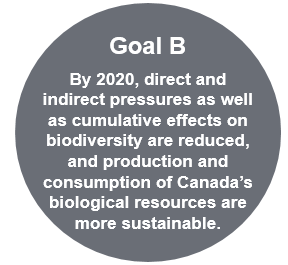Canada Target 6. By 2020, continued progress is made on the sustainable management of Canada's forests.
Indicators:
Relevant indicators drawn from the existing suite of indicators in the Canadian Council of Forest Ministers (CCFM) Criteria and Indicators (C&I) Framework
About the Target
Resilient forest ecosystems are essential to biodiversity in Canada, as well as to the health and wellbeing of its communities. As stewards of 9% of the world’s forests, including a vast portion of the world’s boreal forest, Canada has a major role to play in ensuring that our forests remain resilient and are managed in a sustainable manner. About two-thirds of Canadians – and over 1.1 million Indigenous people – live in or adjacent to forested areas. The Canadian forest industry accounted for 184,510 direct jobs in 2020 and is one of the largest employers of Indigenous people in the country. Sustainably managed forests support these communities while also responding to domestic and international consumer expectations for sustainably sourced products.
Canada’s forests provide habitat to many species, along with key ecosystem services including air and water filtration and carbon sequestration. Forests play a critical role in climate mitigation and adaptation.
While Canada enjoys large tracts of forest land and other wilderness areas, Canadians cannot take them for granted. The changing climate is increasing the risk of natural forest disturbances such as fire and pests. Continuing to implement Canada’s sustainable forest management practices maintains resilient forest ecosystems that support vibrant communities, stronger collaborations with Indigenous peoples, biodiversity, and a green economy.
Protecting and sustainably using forests is necessary to ensure they provide benefits for the long term, such as supporting vibrant communities, stronger collaborations with Indigenous peoples and a green economy.
Canada Target 6 is linked with the following global Aichi target under the United Nations Convention on Biological Diversity Strategic Plan for Biodiversity 2011-2020:
Aichi Target 4 - By 2020, at the latest, Governments, business and stakeholders at all levels have taken steps to achieve or have implemented plans for sustainable production and consumption and have kept the impacts of use of natural resources well within safe ecological limits.
Aichi Target 5 - By 2020, the rate of loss of all natural habitats, including forests, is at least halved and where feasible brought close to zero, and degradation and fragmentation is significantly reduced.
Aichi Target 7 - By 2020 areas under agriculture, aquaculture and forestry are managed sustainably, ensuring conservation of biodiversity.
2020 Final Assessment
As of 2020, forest area under long-term management plans increased by 13% since 2010 while the amount of forest area located within legally established protected areas was just under 30 million hectares, an increase of about 5%. Forest biomass has been estimated to have declined slightly since 2010 with an overall decline of about 5% since 1990. In 2019, the amount of timber harvested was 64% of the sustainable wood supply.
The target has been met given that there has been continued progress on the sustainable use of forests in Canada. On the other hand, there remains room for improvement and there are key gaps in information. A measure of forest biodiversity that accounts for changes in habitat quality and ecosystem integrity is needed. The decline in forest biomass, mostly due to losses from fire and pest infestation, is a possible indication of existing and future problems in maintaining or enhancing biodiversity in Canadian forests.
Contributing Actions
Federal, provincial and territorial governments are committed to redoubling efforts to conserve Canada’s biodiversity as outlined in the Pan-Canadian approach to transforming species at risk conservation in Canada. A key sector identified under the pan-Canadian approach is forestry. Similarly, forest set-asides have been identified as having potential as areas that may currently meet the pan-Canadian definition of either a protected area or an OECM, or have the potential to do so.
In 2019, Natural Resources Canada’s Canadian Forest Service published five National Research Agendas to guide the forest science, research and engagement activities over the next 10 years. Of those, “Enhancing Sustainable Forest Management Practices in Canada” presents Canada’s commitment to ensuring that its forests maintain their environmental, social, cultural and economic values now and into the future.
The Federal Community of Practice on Urban Forest Science and Policy, jointly created by Health Canada and the Canadian Forest Service of Natural Resources Canada, aims to help identify urban forest research needs and foster collaboration among scientists and policymakers from federal departments and agencies working on urban forest issues.
Tree Canada’s National Greening Program targets areas where there is a need for reforestation or afforestation due to human activity or other causes. The work contributes to the restoration of forests and wildlife habitat.
Tree Canada has published a third iteration of a national urban forest strategy for Canada (2019-2024). The Canadian Urban Forest Network, along with municipal, provincial and federal representatives, provided directions. The vision is to have sustainable, biodiverse and healthy urban forests that protect and enhance the well-being and prosperity of Canadian communities.
A number of large Indigenous Protected and Conserved Areas (IPCAs) have been established in the boreal forest. For example, in 2018, Edéhzhíe was established covering 14,218 km2 in the Dehcho region of the Northwest Territories, containing significant habitat for migratory birds and species at risk.
The Ecosystem Management Emulating Natural Disturbance (EMEND) Project is a large-scale long-term experimental research project in forest ecology initiated in 1998 to determine how practical forest harvest and regenerative practices can best maintain biotic communities, spatial patterns of forest structure and functional ecosystem integrity in comparison with mixed-wood landscapes that have originated through wildfire and other inherent natural disturbances. The project is ongoing and will run for approximately 80-100 years (one forest stand rotation).
The project is centered at the University of Alberta and is a collaboration among numerous research agencies, provincial and federal governments, and the forest companies operating in northwest Alberta.
EMEND takes a holistic view of boreal forest management by looking at topics such as: stand dynamics, understory vegetation, arthropod diversity, silvicultural practices, coarse woody debris management, soil properties, carbon management and many others. Partners have already been relying on results from EMEND to improve sustainable forest management policies and practices.

